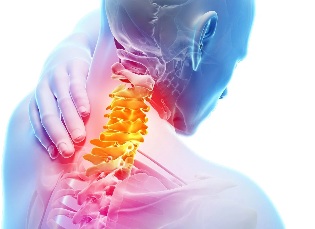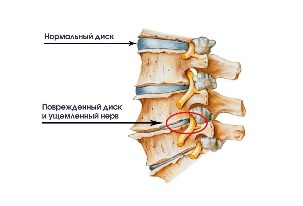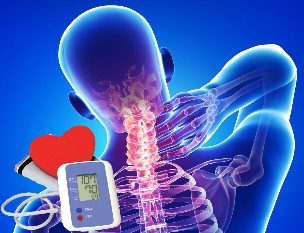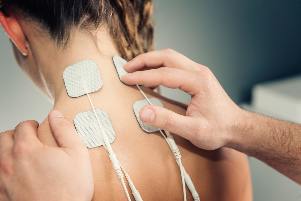The cervix has a certain osteochondrosis dystrophic intervertebral discs changes in the neck.

The negative impact affects not only the discs themselves but also of the vertebrae, the cartilage in the soft tissues. The main feature of the cervical spine, is the fact that your most of the vertebrae are not reliable, the structure is in comparison to the other sections, which makes the area very vulnerable. The vertebrae there are in the vicinity of the drug-the second, in that of the arteries, which carry the power of the human brain.
If there is a shift of the vertebrae, the possibility of compression of nerve in the arteries of the fibre, which will go to the inevitable formation of hernias in between the vertebrae in the protrusion, i.e., a change in the structure of the spinal column is a disc.
What is it?
Osteochondrosis of the cervical spine (Osteohondroz) is a degenerative-dystrophic lesions of the intervertebral discs, which is the same damaged discs, the vertebrae in the joints of the cervical, decrease of height of intervertebral discs. The disease is progressing, if it is not treated in the to cause headaches, circulatory problems in the even of a hernia. Such as osteoporosis, a disease that occurs due to a disorder of the metabolism of the minerals, which causes the bones in the joints, become less severe.
Osteochondrosis can lead to instability of the cervical spine (the symptoms of the treatment as similar to the chondrosis, but also have a number of features, which is often accompanied by a displacement of the vertebrae. To promote the development of a degenerative disease of the disk, destroying the backbone of the Department.
The stage
The attending physician should determine the level of development of degenerative changes, cervical disc disease, which is based on the history of the conduct of the examination of the patient. Are separated by only four degrees:
- The first-rate. The disease in the Bud and the patient is of a slight pain in the neck, which can be more intense when the person starts to turn his head.
- For the second stage. The Patient can complain of severe pain in the cervical spine, which may be stored in the upper extremities. The clinical picture of the share, that, at this stage of the development of the disease is observed, a pinched nerve fibers causing intense pain. It is also important to note, headache, nausea, General weakness.
- Of the third degree. The pain almost becomes a continuous, radiating in the shoulder or in the hand. Some of the patients with a diagnosis of a hernia of the intervertebral discs, which leads to no loss of sensation of the upper extremities. While health is the main noticeable is the reduction in the mobility of the cervical, and pain on palpation.
- The fourth-degree. At this stage of the disease the intervertebral disc is almost completely destroyed. In its place, the connective tissue is that doesn't result in a deterioration of the patient. He starts to feel the pain, the noise in his head, poor sense of orientation in space. That indicates that it is clamped the artery, which prevents the natural power of the brain.

The symptoms of degenerative disc disease of the cervical
Significant symptoms of degenerative disc disease of the cervical as, dizziness, headaches, arterial pressure surges.
The diagnosis of the disease is difficult, and sometimes it is a pain, who do not know the symptoms of that character, in addition to this, the uncontrolled use of strong analgesics mask the character of the disease. The patient is no longer feeling the pain it feels to be healthy, to be continued until the development of irreversible processes in the tissues of the joints in the neck.
Headache in cervical osteochondrosis
It is one of the most common non-specific sign of many diseases. Headaches characterized by a particularly for the female population. It is difficult to determine the cause of the headaches, in addition to this, it is combined with injuries of the spinal column. There are about 14 different reasons for headache in human beings.
Best would be a common cause of headaches is described by the pathology:
- Spasm of cerebral vessels;
- A pinched nerve roots;
- A reflex increase in intracranial pressure.
Headache in cervical osteochondrosis, can you recall the feeling when, hypertension, angina pectoris, or stroke. Especially in middle-to older people, they tend to have a risk of developing a stroke or a heart attack.
The sensation of pain may be paroxysmal, constant, throbbing, the dull.
When heart disease, they complain of the patients in the chest pain accompanied by a disorder of the rhythm of the heart. For the determination of the cause only by a qualified physician. In the case of headaches combined with nausea and dizziness in a pain in your chest, for the care of the ECG.

Dizziness with cervical osteochondrosis
However, this condition is not always clear to preach to the degenerative disc diseases of the cervical spine.
The monsters in the land, so that it may be the result of:
- Inflammation of the middle or inner ear;
- Spasm of cerebral vessels;
- Violations transmission of nerve impulses;
- Problems with the vestibular apparatus;
- Diseases of the heart, in the circulatory system.
There is no clear-cut criteria, and dizziness osteochondrosis. There are, however, a systemic non-systemic dizziness, they're both different variations.
It is recommended that you know the difference between a systemic non-systemic dizziness, to help you to find out the causes of strange State:
- The system of dizziness, is a feeling of a circular motion of the surrounding objects or to the body, which is a consequence of the disruption of apparatus, vestibular, visual analyzers of the receptors in the joints, the muscles in the epidermis (lower back pain, of various etiologies);
- The non-systemic dizziness, is a feeling of faintness, a feeling of stunned, you know, the state is in the vertical position. When a non-systemic dizziness, feeling of circular rotation is lacking in a significant difference in the comparison of the sign.
The people who consider the temple, one of the species is to be monitored by an experienced physician, in particular, or a neurologist, if there is a suspicion on disease of the ear in the emerging music groups) by an otolaryngologist.
The reason for the emergency in-hospital treatment, not related to degenerative disc diseases of the cervical spine, is the identification of the patient (except for the vertigo), take the signature, like this:
- The facial paralysis of the numbness of the shoulder belt;
- Severe headache, on the grounds of health;
- Violation of coordination of movements;
- The loss of, or loss of consciousness.

The blood pressure of the cervical osteochondrosis
The relationship of cervical degenerative disc disease with irregular blood pressure has long been established. The cervical vertebra is so important to the nerve endings in the blood vessels.
The characteristic changes in the pressure of the day. High blood pressure for a long period of time is not a characteristic of the disease. The Reflex irritation of the nerve endings in the short-term spasms of the blood vessels causing an abrupt diurnal dynamics of arterial hypertension.
A distinctive feature of the increased pressure in the cervical osteochondrosis of the neck is to see a combination of the following symptoms:
- Headaches;
- The pains in the limbs, in the chest;
- To reduce the sensitivity of the neck area;
- The occurrence of the pressure peak after stress, muscle tension, prolonged stay in an uncomfortable position, in a similar situation.
These characteristics should be taken into account in the self-differentiation of hypertension of different Genesis.
The tip of the HELL of a rapid deterioration in health, as a basis for a finding of emergency medical care.
Syndromes of osteochondrosis
The clinical picture of cervical degenerative disc disease, which takes place in some of the syndromes. A syndrome of symptoms, it's more that they appear.
The pain in the low back is made up of the following syndromes:
- The vertebrae of the. It is also called the vertebrae, which indicates that it involved in the pathological process of the bone into the cartilage. The water is not the occurrence of the following symptoms: the motor activity of the neck, and the pain when he bends, radiographic changes in the image of the cervical spine. That is, the simultaneous occurrence of the following characters of the vertebrae of the syndrome. A similar set of clinical signs, in the same myositis (the pathology of muscle tissue) is in a painful movement, the accompaniment of a number of other diseases.
- Syndrome of a vertebral artery. It is Displayed when there is involvement of the vascular bundles, which is a responsible for the the flow of blood to the tissues of the Central nervous system. The symptoms indicate that the brain tissue is properly terminated to receive the amount of nutrients. How to recognise this syndrome? The first signs of this, and dizziness, the sensation of noises in the ears, changes in blood pressure, the emergence of a "veil" in front of your eyes. That indicates that it's one of the vertebral arteries is a stavlennia to the state. Each vessel has its own nerve endings. If you are the type of those which Innervate the vertebral artery, it appeared to be a headache, numbness, transient loss of vision on one side. In the end, the vascular changes lead to the fact that, as the brain needs the oxygen. In the meantime, the person feels drowsiness, transient impairment of consciousness, loss of focus, the control, the less it works, in it you will learn the information. The image should be to be separate of cervical degenerative disc disease with atherosclerosis of the vertebral arteries, and the compression or inflammation of a tumor.
- One of the syndrome. He saw a burning feeling in the chest,with dyspnea. The man knows his frequent palpitations, becoming tired of the irritating. This model is characterized by the cardiovascular disease for instance angina, coronary syndrome, heart attack napad. The exact conclusion about the causes of the symptoms of a be after the patient undergoes EKG.
- Radicular syndrome. The cervical innervates the 8 pairs of nerves, each of which has a root of the nerve of the city, which is iz and the exit of the spinal column. Their involvement in osteochondrosis, the patient has a decreased sensitivity to the memory of the pain. Pride and joy, numbness of the nape of the neck, you Can, if you have a sensitivity to reduced sensation of the tongue, the ear, pain in the supraclavicular. Sometimes, disorders of swallowing, the movement of the upper limb, numbness in the fingers.
First aid for an initial period of exacerbation of osteochondrosis
When in severe pain you can use painkillers, such as Analgin, Tempalgin, or Baralgin. The above, If it does not bring about the relief of medications that you can take a nonsteroidal anti-inflammatory drugs (Nise, or Diclofenac).
It is often used a "diversionary" means, for example, the Capsicum plaster that does not heal, but only a painful and heated in a disincentive for the area of the pain. In the case of the design of oedema in the area of the inflammation, the patient can drink the infusion of herbs, or a diuretic for 3-4 days. Is it possible to cure osteochondrosis of the of these methods? These measures are only temporary, for the treatment of the grounds, you'll need to contact your health care provider.
It should be Noted, however, in what the physician treats the back pain. If you suspect that the cause of pain in the cervical spine is the occurrence of lower back pain, you should consult with a neurologist. This is the specialist focus of the disease in this species. In some medical institutions, a narrowly focused specialists, who are especially concerned with the diseases of the spinal column. If you are the clinic of the spine, it is necessary to put the issue on how to treat that ailment behind him.

How to treat osteochondrosis of the cervical?
In the early stages of the development of the treatment of low back pain without drugs, it is enough to change your diet, daily routine, on a regular basis to perform a complex of special exercises. With the advanced forms of the efficient treatment of the disease is possible only under condition of the use of a variety of drugs that help to delay the degenerative changes in the vertebrae.
In the complex of therapeutic measures necessary to contain the physiotherapy – electrophoresis with drugs, ultrasound, magnetotherapy, laser therapy. This method can help in order to deal with the pain, irritation, swelling of tissues, improves metabolic processes in the blood stream.
Medicine
The main methods of treatment of diseases of degenerative disc cervical spine medicine, physical therapy, massage of the neck, in the neck area, is a particularly effective therapeutic exercises with cervical osteochondrosis. The main groups of medications used in these diseases as follows:
| The name of the | The principle of operation of the |
| Non-steroidal anti-inflammatory drugs (nsaids). It is voltaren, Nise, Movalis, it was a Ketonal, Ketanov, diclofenac, ibuprofen, in the of the other | To reduce the pain, reduce the inflammation of the swelling of the spine of the damaged nerve. |
| Drugs that improve blood rheology in blood flow to the. For aminophylline, trental. | The improvement of the nutrition of the damaged nerve roots in improve the the flow of blood to your brain. |
| The B vitamins, it Is combilipen, hungama, milgamma, neurobion. | The improvement of the metabolic processes in the nervous tissue. |
| The muscle relaxants. By mydocalm, sirdalud, chiseled, that ezetimibe, etc. | Thus, drugs that relieve muscle spasm. |
| Chondroprotectors. It (the glucosamine in chondroitin) artra, teraflex, doppelgerts, toadstone, Andronova, structovis, alflutop. | It is a medication, which is the reconstruction of the cartilage tissues, including the damaged intervertebral disc. |
Taking a pill of degenerative disc disease, it should be noted, however, that a significant effect of the treatment with pills only if combined with other techniques, including exercise. It should also be noted, however, that the moral standard of the treating physician's name for the treatment of a disease as a result of its own stage to the other features.













































